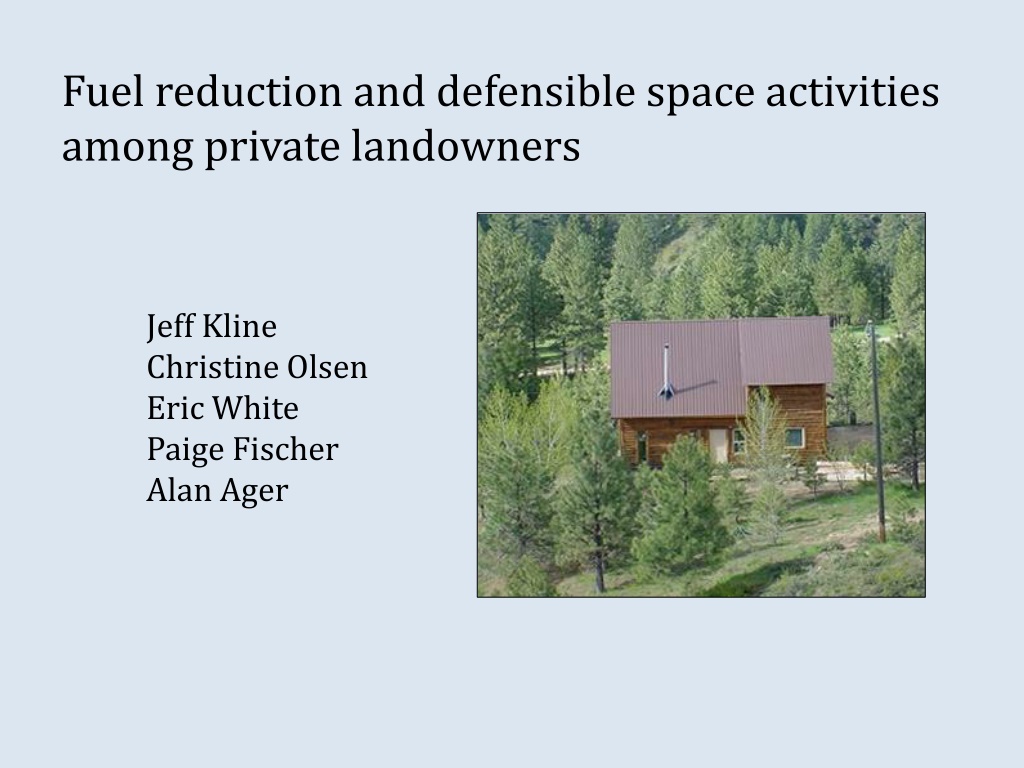Understanding Wildfire Risk Mitigation Among Private Landowners
Activities involving fuel reduction and defensible space are crucial among private landowners for mitigating wildfire risks. Factors influencing mitigation behavior include wildfire hazard, past experiences, perceived risk, and social context. Information from local government agencies and fire awareness groups can positively influence homeowners' risk mitigation efforts.
Download Presentation

Please find below an Image/Link to download the presentation.
The content on the website is provided AS IS for your information and personal use only. It may not be sold, licensed, or shared on other websites without obtaining consent from the author. Download presentation by click this link. If you encounter any issues during the download, it is possible that the publisher has removed the file from their server.
E N D
Presentation Transcript
Fuel reduction and defensible space activities among private landowners Jeff Kline Christine Olsen Eric White Paige Fischer Alan Ager
External Drivers Forest policies, markets External Drivers Climate change, population growth Other Change Processes Vegetation succession, fire behavior, housing expansion Decision Making Actors US Forest Service, Bureau of Land Management, State of Oregon Social Networks Volume/ area targets with constraints and preferences Actions Cut trees, Reduce surface fuels, Firewise homes, Develop land Conservation Corporate forest owners Forest Products Landscape Condition Tribes Government Home- owner Non- industrial forest owners Fire Landowner preferences and values Protection Landscape Outputs Forest products, terrestrial biodiversity, wildlife habitat, landscape amenities, fire area, fire hazard, carbon Homeowners
Conclusions Perceived wildfire risk and mitigation effort are sensitive to fuel conditions on the ground: Trees per hectare Probability of wildfire Chance of damage to property or home Property owners with past wildfire experiences perceive greater risk and are more likely to take mitigation actions
Conclusions Information from local government agencies appears to have little influence on wildfire risk perception by homeowners But information from fire awareness groups does appear to have an effect Information from both local government and fire awareness groups appears to have a positive influence on homeowners risk mitigation efforts
Factors influencing mitigation behavior Wildfire hazard Values at risk Perceived wildfire risk Past wildfire experience Protective action Capacity Social context Perceived responsibility
Approach Two surveys: Nonindustrial private forest landowners in study region. Homeowners in wildland-urban interface areas in study region.
Non-industrial private forest landowners Parcel size of 2.5 acres or more At least 10% forested Ranches and LLC entities (non-timber) included 11,000 NIPF taxlots
Factors influencing fuel reduction among NIPF owners Factor Trees per hectare Past wildfire within miles Insect infestation nearby Forest Service information Structure on the property Effect + ++ ++ + +++
Homeowners Survey in WUI Intermix Interface Summer 2012 before Pole Creek 531 responses
Components of perceived wildfire risk among homeowners Perceived chance of wildfire Perceived chance of damage = x Perceived wildfire risk
Components of perceived wildfire risk among homeowners Chance of wildfire (%) Burn probability Wildfire within miles Prescribed burn in miles Advice: family/neighbor Advice: local govt/FD Advice: fire awareness Property owner College-educated Chance of damage (%) Conditional Flame length Trees per hectare Wildfire within miles Prescribed burn neighbor Advice: family/neighbor Advice: local government Advice: fire awareness + ++ +++ +++ + +++ ++ +++ +++
Predicting Firewise activity Firewise activity Perceived wildfire risk Wildfire in neighborhood Advice: family/neighbor Advice: local government Advice: fire awareness Property owner Tenure Age HOA rule + ++ +++ +++ ++ + -- +++
Policy implications Property owners seem to understand the wildfire risks they face in this fire-prone landscape But some owners can use assistance with how to mitigate wildfire risk Uncertain what types of assistance or other incentives might be most effective for inducing greater mitigation effort Information, cost-sharing, technical assistance
56% of NIPF owners reduce fuel Activity Mow, prescribe burn, thin Mow, prescribe burn Mow, thin Prescribe burn, thin Mow only Thin only % 13% 1% 36% 9% 22% 19%
Bend Keith Olsen










































